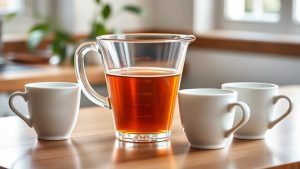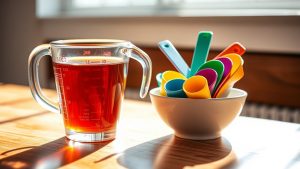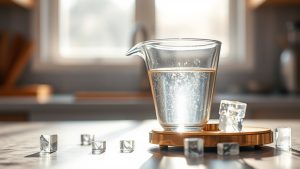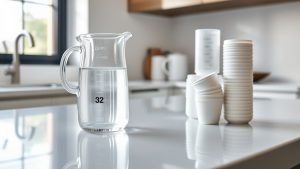
There are 4 cups in 32 fluid ounces. To determine this, you simply divide 32 by 8, since 1 cup equals 8 fluid ounces. Accurate measurement is vital in cooking, as it directly impacts flavor and texture. Remember, this conversion only applies to liquids, not dry ingredients, which differ in weight. Mastering these conversions will enhance your culinary skills, so keep exploring the distinctions between liquid and dry measurements to achieve better results.
Have you ever wondered how many cups are in 32 ounces? This is a common question, especially when you're working with liquid ingredients in cooking or baking. To simplify things, you can use the conversion ratio where 1 cup equals 8 fluid ounces. This means that to find out how many cups are in 32 ounces, you simply divide 32 by 8. The calculation gives you 4 cups. So, if you're measuring out a recipe that calls for 32 fluid ounces of a liquid like water or milk, you'll need 4 cups. Additionally, it's useful to know that 1 fl oz equals 1/8 c, which helps clarify the conversion process.
Understanding this conversion is essential because it applies specifically to liquid ingredients. When you're preparing a dish, you often encounter recipes that list measurements in either cups or fluid ounces. Being able to convert between these two units helps guarantee accuracy in your cooking. For example, if a recipe requires 16 fluid ounces, you can quickly determine that this is equivalent to 2 cups. Similarly, 24 fluid ounces equals 3 cups.
Mastering the conversion between cups and fluid ounces ensures precision in your cooking and baking endeavors.
It's important to note that fluid ounces measure volume for liquids, while dry ounces measure weight for ingredients like flour or sugar. This distinction is key because the conversion from fluid ounces to cups won't work for dry ingredients without considering their density. For instance, while 1 cup of liquid might weigh 8 ounces, 1 cup of all-purpose flour weighs about 4.4 dry ounces. This variability means that if you're working with dry ingredients, you'll need to approach conversions differently.
When you're following a recipe, precise measurements can greatly affect the final outcome. If a recipe calls for a specific volume of liquid, using the correct conversion guarantees that you maintain the intended flavor and texture. Recipes might use ounces or cups interchangeably, but understanding how to convert between them can make cooking more manageable. For liquid measurements, fluid ounce conversions are straightforward, while dry ingredient conversions require additional consideration due to their unique properties.
For those who often cook or bake, having access to online resources can be incredibly helpful. Many websites provide calculation tools to assist with fluid ounce to cup conversions. Additionally, measurement charts can help with frequent conversions you encounter in the kitchen. These tools not only make it easier to adapt recipes but also enhance your understanding of measurement systems.
Finally, mastering these conversions requires basic math skills and practice with examples. By working with recipes, you can solidify your grasp of fluid and dry ounces. Recognizing the difference between these units is essential for both culinary success and scientific precision. Just as clear measurement communication is significant in scientific writing, it's equally important in the kitchen to avoid any confusion.
Conclusion
To sum up, when you're measuring out 32 ounces, you'll find it equals 4 cups. Imagine pouring that rich, fragrant coffee into four steaming mugs, each brimming with warmth and comfort. Whether you're hosting friends or enjoying a quiet morning, knowing this conversion can simplify your cooking and baking adventures. So, next time you reach for that measuring cup, you'll confidently know how to transform ounces into cups, making your culinary creations even more delightful.



